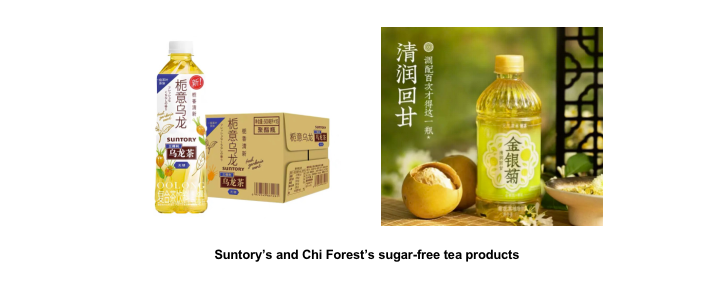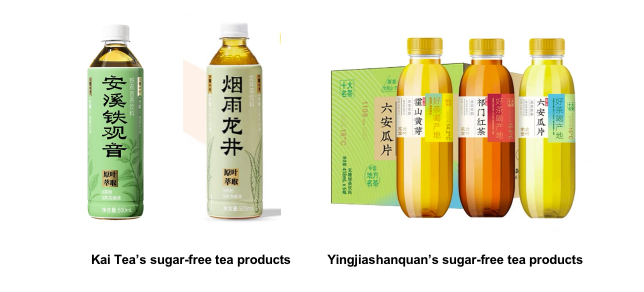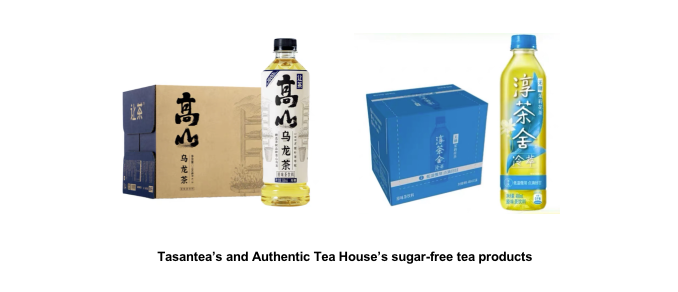With consumers’ increasing health awareness, sugar-free tea products, which are healthy and natural, have been welcomed in the Chinese market in recent years. The category has maintained a high growth rate since 2017 and reached CNY 7.38 billion in 2022, with a compound annual growth rate (CAGR) of 28.6% from 2017-2021. [1]
The rapidly growing market has attracted the participation of numerous enterprises, leading to the continuous release of zero-sugar tea products by various brands. In March 2022, Wanglaoji, a renowned Chinese herbal tea giant, announced a new sugar-free herbal tea with camellia flavour. In May 2022, Heytea, a popular Chinese milk tea brand, unveiled a zero-sugar barley tea product. In June 2022, Tsingtao, a prominent beer giant in China, also introduced a sugar-free barley tea product with zero caffeine.

Currently, there are mainly three types of brands in the Chinese market. The first type is traditional brands and the sub-brands under them, which consolidate market share by expanding their product portfolio, such as Suntory, Master Kong, Oriental Leaf of Nongfu Spring and Authentic Tea House of Coca-Cola. The second is emerging brands like Chi Forest and Tasantea, which enter the sugar-free tea market through the innovation of ingredient, taste, and packaging, etc. The third is crossover brands with advantageous resources in beverage-related industry chains and channels, such as Naixue, Heytea, etc. As many brands stepped into the zero-sugar tea track, the market is in fierce competition. At present, the top 5 best-selling sugar-free tea brands on Taobao are Suntory, Oriental Leaf, Linlong Tea House, Rancha and Master Kong. [1] In order to gain more market share, brands spare no effort to attract consumers by improvement in tastes, ingredients, techniques, etc.
Tastes
Sugar-free tea products used to be viewed as unpleasant drinks due to their bitter taste. Nongfu Spring’s zero-sugar product Oriental Leaf was once listed as the top 5 unpleasant drinks in China, roasted by consumers as overnight tea.

Oriental Leaf’s sugar-free tea products
Nowadays, although consumers’ acceptance of the plain taste of sugar-free tea is higher than before due to their focus on health, they still expect sugar-free products with pleasant tastes. Therefore, brands strive to utilise fruits and flowers to ameliorate the product flavour. For instance, Suntory’s new sugar-free product combines gardenias with oolong tea, providing consumers with a novel composite flavour with the fragrance of flower and the freshness of tea. One of Chi Forest’s zero-sugar products contain chrysanthemum and honeysuckle as ingredients, together with snow pear and siraitia grosvenorii, to make the product taste fresh and sweet.

Ingredients
Apart from tastes, the ingredients used in sugar-free tea products play a crucial role in consumers' purchasing decisions. Firstly, since one selling point of these products is that they are healthier than many other beverages like carbonated drinks, their ingredient lists are supposed to be clean. For example, Chi Forest’s barley tea product only contains water, baked grains, vitamin C, and sodium bicarbonate.
Additionally, selecting renowned tea species to enhance product quality is also useful to increase brands’ competitiveness. Kai Tea launched two sugar-free tea products made from Tieguanyin and Longjing Tea, two of China’s top ten prestigious tea species. Yingjiashanquan also rolled out three zero-sugar products, made from two of China’s top ten prestigious tea Lu’an Leaf and Keemum Black Tea, and Ming Dynasty’s tribute tea Huoshan Huangya. These ingredients are all selected from their core producing areas so as to offer sugar-free tea products with good quality.

Techniques
In order to restore the original flavour of tea, brands employ various techniques to manufacture sugar-free tea products. For instance, on the basis of 100% extraction of original leaves, Tasantea chooses a combination of steaming and roasting technology to retain the aroma and colour of tea for its high mountain tea series. Authentic Tea House adopts the cold extraction process, which brews tea at a low temperature. This technique enables products to achieve a refreshing and sweet taste, since the sweet amino acid molecules in tea can dissolve in cold water, but the sources of bitterness, tannic acid and caffeine, will not be released due to low temperate.
 In the future, sugar-free tea products will possibly become the main driver of China’s tea beverage market. The taste, ingredients and techniques of the products are still consumers’ primary focus. According to a survey of consumers who frequently purchased sugar-free tea in the past six months, fresh and sweet products with rich aroma are preferred by them, especially by the drinkers of these new and light zero-sugar tea drinkers, which can be the future direction for product upgrade. Additionally, the improvement of ingredient quality and techniques is essential to increase consumers’ repurchasing behaviour. Enhancement like superior tea species, more refined extraction technology, purer tea flavour, and fresher taste is all appealing to them. [1]
In the future, sugar-free tea products will possibly become the main driver of China’s tea beverage market. The taste, ingredients and techniques of the products are still consumers’ primary focus. According to a survey of consumers who frequently purchased sugar-free tea in the past six months, fresh and sweet products with rich aroma are preferred by them, especially by the drinkers of these new and light zero-sugar tea drinkers, which can be the future direction for product upgrade. Additionally, the improvement of ingredient quality and techniques is essential to increase consumers’ repurchasing behaviour. Enhancement like superior tea species, more refined extraction technology, purer tea flavour, and fresher taste is all appealing to them. [1]
**Disclaimer: The cover image and all images used in the article are from the Internet.














